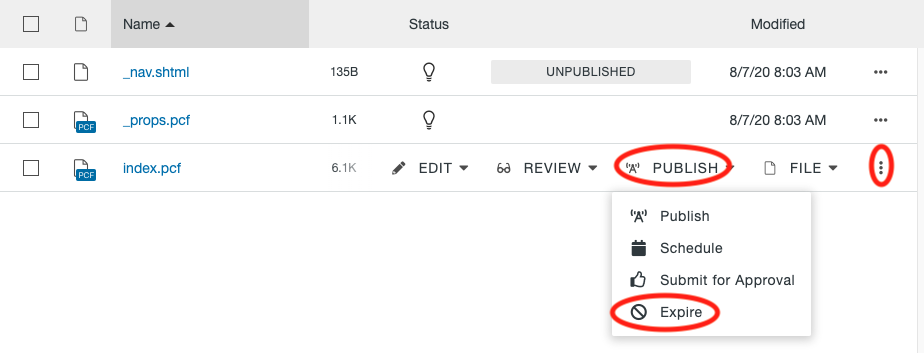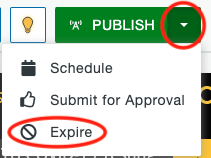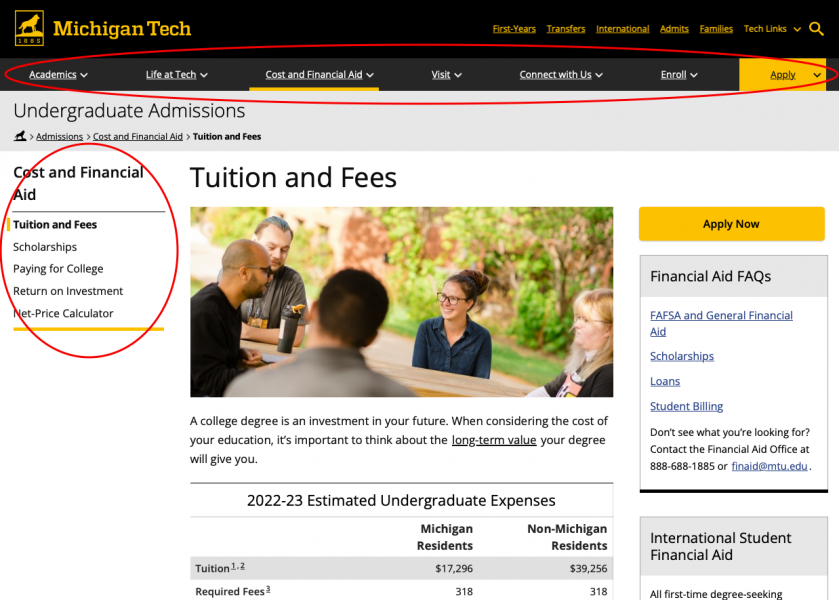Interactive images, where the user can move around in the image to view the scene from every angle, 360 photos are becoming more widespread and easier to create. You can embed them on your Modern Campus CMS website in the upper page image or within the body content.
To remove content from a live site, pages and files must be moved to the Recycle Bin. Pages that are moved to the Recycle Bin can be restored, if necessary. When a page is recycled the published content is automatically removed. Once a page is deleted from the Recycle Bin or a folder is deleted, it can no longer be retrieved. Files that have been in the Recycle Bin for two years or more will be deleted twice yearly, in November and May.
If you are removing an entire folder, you should first check dependencies and remove all subscribers for all content items within the folder, then recycle the folder. Recycling an entire folder will not warn you of any dependencies for files inside.
You can schedule a page to expire at a specific date and time. The available options depend on the file type and your access permissions. Expire options can be reached from the Pages List View by opening the More Actions menu and selecting Expire under the Publish dropdown or from the dropdown arrow next to the green Publish button when you have the page open.
There are different options for expiring content, Replace or Recycle. For each option you have the ability to send a notification to yourself or a group of users. It will be sent with the CMS and you can select the Send Copy to Email checkbox to also send a notification to the user’s Michigan Tech email. You will select the To from the dropdown, enter a Subject, and enter a Message.
Before removing any page you should first check its dependencies.
You can publish content at a later date using the Scheduled Publish tool. A scheduled publish can only be canceled or modified by the user who set the schedule.
Scheduled Publish can be reached from the Schedule Publish tab inside the Publish window, by selecting Schedule from the Publish menu in More Actions on the Pages List View, or by selecting Schedule from the dropdown menu of the Publish button in the Page Actions Toolbar.
Navigation on CMS websites is located at the top of every page as tabs with dropdown lists for subnavigation links. Left navigation is included on internal pages (unless left navigation is manually turned off)—displayed to the left of the content area on desktop or under an “Also in this section” accordion on mobile. The top and left navigation will always match.
Navigation is controlled through the _nav.shtml files automatically created with a new section or additional _nav.shtml files that are created manually. New pages are automatically added to the bottom of the parent navigation file if you select Yes for “Add Navigation Item” when creating them. These files must be published in order for changes to appear on the live site.
Each nav file controls the navigation for the section below it. If you are in the main root folder for a site, the _nav.shtml file will include the tab navigation links only. If you are in the first folder beneath the root folder the _nav.shtml file will have the subnavigation for the tab represented by that folder.
Navigation on the live site can include one additional level beneath this subnavigation, however these links will not appear until the user goes to the parent subnavigation page. Any nav files below that level would not be used on the site. If you are in the most interior page’s folder the _nav.shtml file will only contain the page you are on.
You can preview pages with all changes made in the CMS before publishing. You can also preview files. Preview is available to anyone with access to the site, including users with view-only access. You can preview a page regardless of the checked-out status of the file. If you have the page open, click on the Preview tab in the Page Actions Toolbar.
Additional breadcrumbs can be added preceding those for your site. This is commonly used on some general webpages, like the Faculty/Staff page including a breadcrumb to the Michigan Tech homepage or one of the CSA or COE departments including a breadcrumb back to the college homepage. This is only available in the _props.pcf file within the root folder for your site or the folder where navigation is restarted.
The Properties button in the Page Actions Toolbar near the top of the page contains information about the page. You must have the page checked out to you to see all the options.
MultiEdit Content is where you will set up the header image if you have turned it on in the Parameters. Select the MultiEdit Content option from the left menu in the Properties screen or by using the MultiEdit button at the top of the page edit screen.
Creating faculty/staff listings involves a few steps. First, you must create a Personnel Information for each person. If you are including an employee who is already listed in another department, you will still create the page, but you will pull in content from the other listing. Once that is created you will be able to add people to the listing pages.
The Properties button in the Page Actions Toolbar near the top of the page contains information about the page. You must have the page checked out to you to see all the options.
The Page Parameters section, which can be selected from the left menu or in the Page Parameters Gadget, contains the following options.




